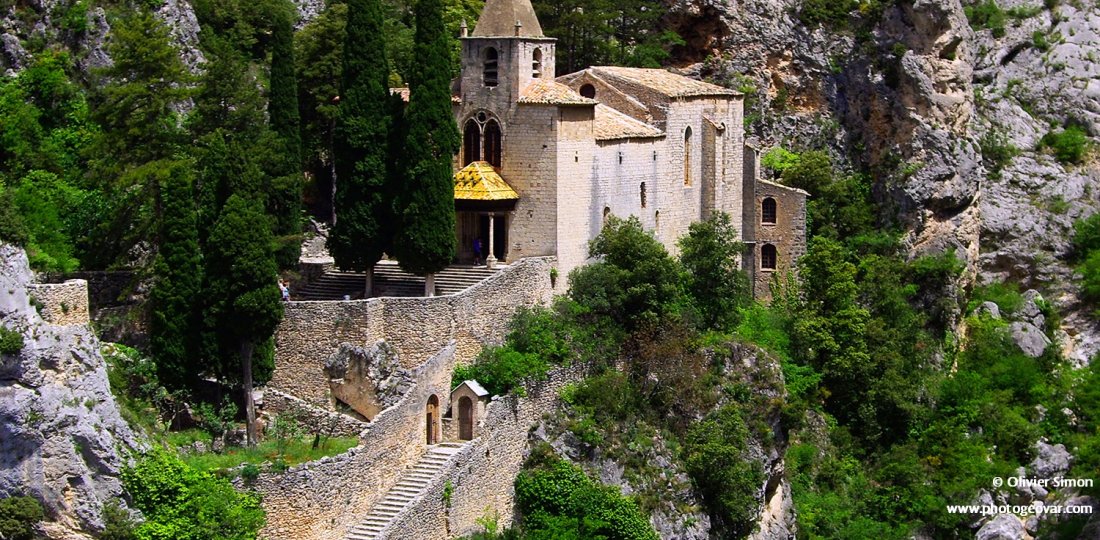Parish church
Listed as an historical monument in 1913, the church proudly carries its old Lombard bell tower, with its very unusual structure (one of the most beautiful in Provence). The square tower in lime stones is twenty-two meters high, divided in four floors with dual openings. Dating from the XIIth century, it is one of the rare moving bell towers listed in Europe.
The Romanesque nave, of the same era, is divided in five spans with barrel vaults. The walls flare out at the top, which is a rather current phenomenon in Romanesque churches. The external walls act like a reinforcement. Three later chapels with semicircular vaults open onto this nave.
Pierre de Pratis, commendatory prior, ordered the church to be enlarged in 1336. The axis of the nave was not respected and it is not known if the prior wanted to incline the choir in the direction of Jerusalem or to remind of the position of the head of Christ on the cross. The current altar is a IVth century white marble sarcophagus that depicts the Red Sea crossing.
The Chapel Notre-Dame de Beauvoir
After climbing the 262 steps of the Way of the Cross, on the flank of the hill, you reach the chapel that overlooks the village. The seven oratories which in the past marked the path were replaced by the fourteen Stations of the Cross in 1860 and were decorated with ceramics made by Simone Garnier.
The small chapel was built in the late XIIth century on the remains of a Marial temple erected in the Vth century. It unites a Romanesque style and Gothic influences from the XVIth century. Like other Alpine chapels, the vocation of the sanctuary of Notre Dame de Beauvoir is the “suscitation”. In the XVIIth century, stillborn babies came back to life for the duration of their baptism. Their souls could then go to Paradise. The Chapel of Notre-Dame de Beauvoir was listed as a historical monument in 1921.
Sainte-Anne chapel
Built in the XVIth century with stones from the walls and towers that protected the area of the ’Paillerols’, it will later be joined with the village cemetery.
The aqueduct
Crossing the Adou to distribute water from the spring to the mills located lower, this remain is now only a witness to past times.
The walls
The cliffs that dominate the village formed a natural line of defence, but Moustiers also protected itself behind walls like many other medieval villages.
The fountains
Like in any other typical Provencal village, the narrow streets of Moustiers are fitted with drinking water fountains, accessible to all. The small squares have magnificent wash-houses where the washer-women used to go in the past.
Visit_Moustiers to know the heritage
Our small village has a rich heritage: a church and a chapel classified as Historic Monument, the remains of a medieval rampart, an ancestral know-how...
Our Application Visiter_Moustiers allows you to know more about the heritage of the past thanks to many old photos: from the old earthenware workshops to the evolution of the Church Notre-Dame de l'Assomption.
Immersive tour of 1h30 to apprehend the heritage of Moustiers-Sainte-Marie in every corner!
Children also have their own adapted route! An excellent way to make them discover the history of Moustiers-Sainte-Marie while having fun answering quizzes or riddles.
+ Discover Moustiers in an original way
To discover Moustiers in an original way, the Tourist Office created 2 booklets:
Moustiers's PHOTO RALLY to spot one of the most beautiful site of town to take THE BEST picture !
Discover the Photo Rally
and Moustiers's TRAKING GAME to learn about the village histoy while searching for clues and details !
A fun way to discover the village ! ☺








